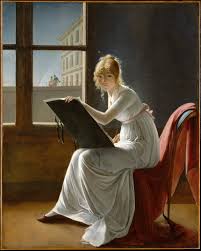The Italian art theoretician Leon Battista Alberti assumes that an artist regards his canvas as an open window. Into this window, he then paints his picture (Leon Battista Alberti, Della Pittura – Über die Malkunst, hg. v. u. übers. v. Oskar Bätschmann u. Sandra Gianfreda, Darmstadt 2002, p. 93).
Let us look at two pictures, ‘Las Meninas’ by Diego Velazquez and ‘Portrait of Charlotte du Val d’Ognes ‘ by Marie-Denise Villers. Is it really as if we look through a window? It seems as if the figures in the pictures expect us. Thus, we might get the feeling that we have already entered the image through a window. We are present in their room, in their home.
We start with Velazquez’ picture. In the foreground we see a trio. Light is cast on them. In the middle there stands a little girl. Her name was Margarita and she was the daughter of the Spanish king Philipp IV. Two maids are at her side.

Behind this girls’ trio we see at the left side Velazquez. He stands in the half-shade. In his hands he holds a painter’s palette. In front of him, but turned with its back towards us, there stands a canvas.
In the room behind Velazquez we can skim further pictures hanging on the walls. They all lie in the shadow. However, one stands out. Diagonally behind Velazquez there is a picture that displays the royal couple. It is a particular picture, as it is a reflection in a mirror.
But where is the royal couple positioned? Do they stand at our place? Or is their picture a reflection of the picture Velazquez is painting?
One thing is for certain, in this room, the royal home, there are various types of images. The king’s daughter poses with her maids as if someone is making a picture of her. Velazquez is painting a picture. And the royal couple appears as a reflection in a mirror.
With these images, the room, the royal home, tells something about its inhabitants: the proud king’s daughter, the obedient maids, the present parents. And Velazquez belongs to them. He has the honour to be at the royal house and paint a picture, most likely of someone of the royal family.
However, a room, a home, can also recount something about its inhabitants with a smaller number of pictures. This is the case in Marie-Denise Villers ‘Portrait of Charlotte du Val d’Ognes ‘. We see Charlotte on a chair. Her left hand holds a folder, the other hand clutches a pen or brush. She has turned her head towards us.

We feel here, too, that she acknowledges us. We seem to be in the same room as her. This room contains no further objects. But the empty walls could also be regarded as pictures. They tell us something about the focus there is on Charlotte and her painting. Maybe there is no need for further things around her. They could distract our concentration from her.
A light coming from behind highlights Charlotte du Val d’Ognes. It nearly seems as if a spot is set on her. Due to this light, she is connected with the outside area where the light seems to come from. On the terrace of a house on the opposite side we see a couple. The woman and man are turned towards each other, they appear to be a love couple.
This room, this home also tells something about its inhabitant. It does it with the help of various pictures. We have the woman Charlotte who is posing as a painter for us, the picture she is painting, the empty walls as well as the picture we see through the window.
We learn this from the home and its pictures: there is a focus on the painting woman. She is connected to the love couple. Charlotte might be the woman of the love couple and the love couple could be the motiv of her picture.
So far we have looked at two pictures. Although they were made at different times, some points are similar. For example, the homes in both pictures narrate something about the present figures. This narration is done with the help of various kinds of pictures: a still of the figures, pictures which are about to be painted, empty walls, reflections in a mirror or pictures seen through a window.
We as viewers are required in order to make a room, a home narrate something about its inhabitants. We are the expected guest whom the figures of the pictures turn to. At the same time, we feel being in the same room as them. And then it is our turn to read the pictures, to figures out their stories.
Article by Katharina Windorfer

I just added this feed to my favorites. I like reading your posts. Thank you!